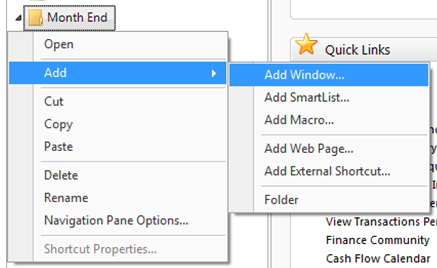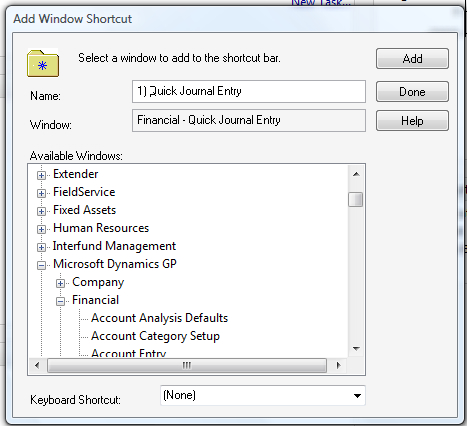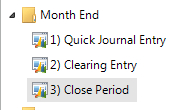Dynamics GP provides options for robust workflow functionality integrated with Microsoft Office SharePoint Server (MOSS) or Windows SharePoint ServicesWSS).
However, for many users this is more functionality than they need.
Additionally, many organizations don't feel they are ready for the cost
and complexity of MOSS. For users who only need a simple workflow to
ensure that they remember the steps for a particular task, a basic
workflow can be built using shortcuts and folders. (
This process works well for
irregular tasks such as month-end or quarter-end processes where tasks
are performed infrequently enough, thus making it easy to forget the
steps. For this recipe, we'll look at setting up a basic month-end
workflow.
Getting ready
The basic steps of this task
are to create a folder to hold the workflow and then to add the steps in
order to that folder. For our example, we will assume that a month-end
financial closing workflow includes posting a Quick Journal, processing a
Clearing Entry, and closing the month.
How to do it...
Here are the steps to create a basic Ad hoc workflow:
1. Click on the Home button from the Navigation Pane on the left. This makes the Shortcut Bar available on the top left.
2. Right-click on the Shortcut Bar and select Add | Folder to add a folder to the Shortcut Bar that can be used to organize entries. Name the folder Month End and press the Enter key. Now, there is a folder to hold month-end entries.
3. The next step is to add our three sample entries. Select the Month End folder on the Shortcut Bar. Right-click on the folder and select Add | Add Window:

4. Click on the plus sign (+) next to Microsoft Dynamics GP. Click on the plus sign (+) next to Financial and select the window named Quick Journal Entry. Change the name at the top to 1) Quick Journal Entry. Click on Add.
Putting a number in front of the text prevents this shortcut from
interfering if the same shortcut appears somewhere else on the Shortcut
Bar:

5. Next, select Clearing Entry also under Microsoft Dynamics GP and Financial. Rename it to 2) Clearing Entry in the Name field and click on Add.
6. Finally, click on the plus sign (+) next to Company under Microsoft Dynamics GP and select Fiscal Periods Setup. Rename this to 3) Close Period and click on Add. Select Done to finish.
7. These items will now appear on the Shortcut Bar on the left under the Month End folder. Selecting an item with the left mouse button will allow moving of these items around to adjust the order if necessary.

How it works...
Ad hoc workflows provide an
option to group a set of steps together and make these all available in
one place. Clicking on the arrow to the left of the folder closes it up
and keeps the steps out of the way until these are needed. Clicking on
the arrow again reopens the folder to run the steps. Some common uses
include creating a basic set of steps for new users, month-end and
quarter-end processes, and any other process where it is important to
ensure that all of the steps are followed.